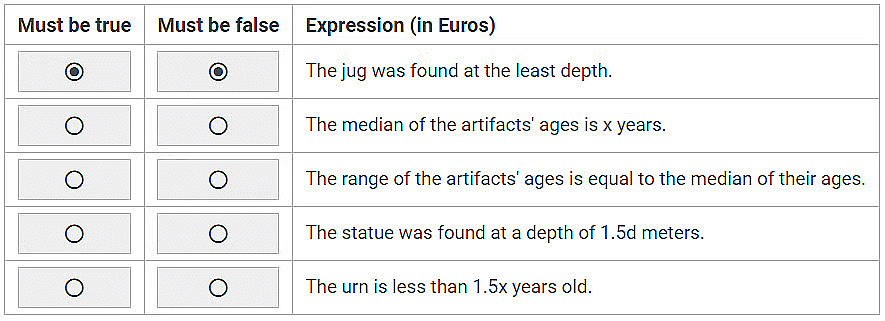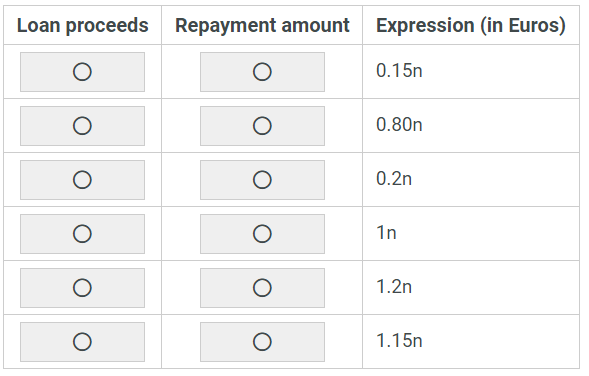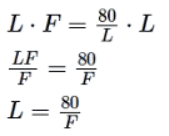Solved Examples
Example 1: Archeologists excavating at a certain site have found the following five artifacts: a bowl, a cup, a jug, a statue, and an urn. At this site, the greater the depth at which an artifact was found, the older that artifact is. The bowl was determined to be x years old and was found at a depth of d meters. Both the cup and the jug were found at a depth of less than d meters. The statue was determined to be 1.5x years old, and the urn was found at a greater depth than the statue was.
Each of the following statements pertains to the five artifacts found at the site. Assuming that the information provided is correct, select for Must be true the statement that must be true and select for Must be false the statement that must be false. Make only two selections, one in each column.

Ans:

Explanation: The greater the depth at which an artifact was found, the older that artifact is.
The bowl was determined to be x years old and was found at a depth of d meters.
Both the cup and the jug were found at a depth of less than d meters.
The statue was determined to be 1.5x years old, and the urn was found at a greater depth than the statue was.
The order of age from oldest to youngest is: urn, statue, bowl, {cup, jug}. The order of depth from deepest to shallowest is: urn, statue, bowl, {cup, jug}.
"Must be True" choice: "The median of the artifacts' ages is x years." To evaluate this statement, we need to arrange the artifacts in the order of their age. The median is the middle value when all values are sorted in ascending or descending order. Here, the bowl is the middle artifact in terms of age, and the bowl is x years old. Therefore, the median age is x years.
"Must be False" choice: "The urn is less than 1.5x years old." Given that the urn was found at a greater depth than the statue, and that a greater depth corresponds to an older age, we can deduce that the urn is older than the statue. We know the statue is 1.5x years old, so the urn must be older than 1.5x years. Therefore, the statement "the urn is less than 1.5x years old" must be false.
Example 2: Promotion: Our pioneering 20/18 reduced-interest loan is the ideal financial aid for swift business projects. Clients can receive a loan up to 85% of the value of their collateralized assets, with an upfront interest deduction of 20%, and are provided an 18-month period to repay the initial loan amount.*
*Loan Conditions: The actual loan proceeds, delivered by check in Euros, are calculated as the original loan sum minus the total loan interest — which is 20% of the original loan amount.
A 20/18 reduced-interest loan loan with amount n Euros is taken out by a business. Select the expressions for the repayment amount (the sum of the payments made to fully repay the loan) and the loan proceeds for this loan. Make only two selections, one in each column.

Ans: Loan proceeds: 0.8n
Repayment amount: 1.00n
Explanation: In this question, the business borrows an amount up to 85% of their collateral assets value, but that loan amount is given to them after deducting the 20% interest upfront. This means, for a loan of amount 'n', the actual loan proceeds (amount received by the business) would be 'n - 0.2n' which equals '0.8n'.
And, when it comes to repayment, the business needs to pay back the original loan amount, which is 'n', regardless of the deducted interest.
Example 3: A Shark XI is a new model remote aircraft. Under ideal flying conditions the Shark XI's fuel is F nautical miles per liter  when flying speed is constant at S nautical miles per hour (S(knots)) where knots is the abbreviation for nautical miles per hour.Identify the following statements in terms of S and F.
when flying speed is constant at S nautical miles per hour (S(knots)) where knots is the abbreviation for nautical miles per hour.Identify the following statements in terms of S and F.
I. Liters of fuel in one hour.
II. Liters of fuel in 80 nautical miles.
(a) I. S/F
II. 80/F
(b) I. F/S
II. F/80
(c) I. S/F
II. F/80
(d) I. F/S
II. 80/F
(e) I. S/F
II. 80/F
Ans: (a)
Explanation: To identify,
I. Liters of fuel in one hour.
Recall the given information,
A Shark XI is a new model remote aircraft. Under ideal flying conditions the Shark XI's fuel is F nautical miles per liter  when flying speed is constant at S nautical miles per hour (S(knots)) where knots is the abbreviation for nautical miles per hour.
when flying speed is constant at S nautical miles per hour (S(knots)) where knots is the abbreviation for nautical miles per hour.

To get liters per hour:

the nautical miles cancel out and the solution is

II. Liters of fuel in 80 nautical miles.

Now solving for liters results in the correct answer,

Example 4: A high-school music department is putting together a two-day music festival to highlight the students' talents. The schedule for the two days will adhere to the following rules:
1. Five musical performances are scheduled for each day.
2. The majority of the performances on one of the days will be composed of woodwind instruments (clarinets, flutes, saxophones, oboes, or bassoons)
3. The other day will primarily feature solo performances.
Currently, 8 of the performances (4 each day) have been scheduled. The music department must add one additional performance on each day:
Day 1
Smooth Jazz Group (10th Grade, Saxophone Trio)
Rock Your Socks Off (12th Grade, Vocal Group)
Dustin & Karen (11th Grade, Flute Duo)
James (11th Grade, Trumpet Solo)
Day 2
Adam (10th Grade, Vocal Solo)
John (11th Grade, Clarinet Solo)
Rachel (12th Grade, Brass Solo)
4 Blind Mice (9th Grade, Woodwind Quartet)
The music department must add one additional performance on each day.
Based on the rules above, identify a performance that following:
I. A performance that can be scheduled on either day.
II. A performance that cannot be scheduled on either day.
(a) I. Susan (12th Grade, Flute Solo)
II. Henry (12th Grade, Violin Solo)
(b) I. Jenny & Molly (12th Grade, Flute Solo)
II. James & Jimmy (10th Grade, Vocal Duo)
(c) I. Susan (12th Grade, Flute Solo)
II. Kimmy (10th Grade, Trumpet Solo)
(d) I. Susan & Tina (12th Grade, Flute and Clarinet Duo)
II. James & Jimmy (10th Grade, Vocal Duo)
(e) I. Susan (12th Grade, Flute Solo)
II. James & Jimmy (10th Grade, Vocal Duo)
Ans: (e)
Explanation: Recall the criteria for this particular problem.
Five musicians are scheduled to play each day. To feature the departments strengths, the majority of the musicians on one of the days will be composed of woodwind instruments (clarinets, flutes, saxophones, oboes, bassoons) and the other day will be primarily solo musicians.
Looking at day one it is clear that represents the woodwind day and day two represents the solo day.
Therefore, for someone to be able to play either day that student must play a woodwind instrument and be doing a solo. For a musician(s) to play neither day it must be a group that is composed of instruments other than woodwind.
Also recall that violins are string instruments, trumpets are brass instruments, and vocal is ones voice.
Keeping all of this in mind, the correct answer is,
I. Susan (12th Grade, Flute Solo)
II. James & Jimmy (10th Grade, Vocal Duo)
Example 5: Over a seven-year period, from 2002 to 2009, the number of babies born to married couples increased despite a decrease in marriages from 17,000 marriages in 2002.
In the given expression, B and M represent the percent change in the babies and marriages, respectively. I represents the number of babies per married couple in 2002. The percent change in a quantity is calculated by the formula:

Identify the following with the given information,
I. The expression that represents the number of babies born in 2002.
II. The expression of the number of babies born per family in 2009.
(a) I. The expression that represents the number of babies born in 2002.
17,000/I
II. The expression of the number of babies born per married couple in 2009.

(b) I. The expression that represents the number of babies born in 2002.
17,000/I
II. The expression of the number of babies born per married couple in 2009.

(c) I. The expression that represents the number of babies born in 2002.
17,000/I
II. The expression of the number of babies born per married couple in 2009.

(d) I. The expression that represents the number of babies born in 2002.
17,000/I
II. The expression of the number of babies born per married couple in 2009.

(e) I. The expression that represents the number of babies born in 2002.
17,000/I
II. The expression of the number of babies born per married couple in 2009.

Ans: (d)
Explanation: To identify,
I. The expression that represents the number of babies born in 2002.
Recall the given information in this particular question.
It is known that in 2002 there are 17,000 marriages and I represents Babies/Marriage.
Using this information to create a mathematical expression is as follows.

Now to identify,
II. The expression of the number of babies born per married couple in 2009.
Use the formula given

This part of the problem is asking for a ratio, but the variables that are given are percents.
Therefore, the 100’s are there because M and B are percent quantities. They are both added because M is a negative number.
So the number in the numerator is the percentage of babies that exist in 2009 compared to 2002 (a number that will be less than 100). The denominator is the percentage of the 2002 marriages that exists in 2009 (a number greater than 100).
Thus the solution is,

Example 6: A high-school music department is putting together a two-day music festival to highlight the students' talents. The schedule for the two days will adhere to the following rules:
1. Five musical performances are scheduled for each day.
2. The majority of the performances on one of the days will be composed of woodwind instruments (clarinets, flutes, saxophones, oboes, or bassoons)
3. The other day will primarily feature solo performances.
Currently, 8 of the performances (4 each day) have been scheduled. The music department must add one additional performance on each day:
Day 1
Smooth Jazz Group (10th Grade, Saxophone Trio)
Rock Your Socks Off (12th Grade, Vocal Group)
Dustin & Karen (11th Grade, Flute Duo)
James (11th Grade, Trumpet Solo)
Day 2
Adam (10th Grade, Vocal Solo)
John (11th Grade, Clarinet Solo)
Rachel (12th Grade, Brass Solo)
4 Blind Mice (9th Grade, Woodwind Quartet)
The music department must add one additional performance on each day.
Based on the rules above, identify a performance that following:
I. A performance that can be scheduled on either day.
II. A performance that cannot be scheduled on either day.
(a) I. Susan (12th Grade, Flute Solo)
II. James & Jimmy (10th Grade, Vocal Duo)
(b) I. Susan (12th Grade, Flute Solo)
II. Henry (12th Grade, Violin Solo)
(c) I. Susan & Tina (12th Grade, Flute and Clarinet Duo)
II. James & Jimmy (10th Grade, Vocal Duo)
(d) I. Jenny & Molly (12th Grade, Flute Solo)
II. James & Jimmy (10th Grade, Vocal Duo)
(e) I. Susan (12th Grade, Flute Solo)
II. Kimmy (10th Grade, Trumpet Solo)
Ans: (a)
Explanation: Recall the criteria for this particular problem.
Five musicians are scheduled to play each day. To feature the departments strengths, the majority of the musicians on one of the days will be composed of woodwind instruments (clarinets, flutes, saxophones, oboes, bassoons) and the other day will be primarily solo musicians.
Looking at day one it is clear that represents the woodwind day and day two represents the solo day.
Therefore, for someone to be able to play either day that student must play a woodwind instrument and be doing a solo. For a musician(s) to play neither day it must be a group that is composed of instruments other than woodwind.
Also recall that violins are string instruments, trumpets are brass instruments, and vocal is ones voice.
Keeping all of this in mind, the correct answer is,
I. Susan (12th Grade, Flute Solo)
II. James & Jimmy (10th Grade, Vocal Duo)
Example 7: Over a seven-year period, from 2002 to 2009, the number of babies born to married couples increased despite a decrease in marriages from 17,000 marriages in 2002.
In the given expression, B and M represent the percent change in the babies and marriages, respectively. I represents the number of babies per married couple in 2002. The percent change in a quantity is calculated by the formula:

Identify the following with the given information,
I. The expression that represents the number of babies born in 2002.
II. The expression of the number of babies born per family in 2009.
(a) I. The expression that represents the number of babies born in 2002.
17,000/I
II. The expression of the number of babies born per married couple in 2009.

(b) I. The expression that represents the number of babies born in 2002.
17,000/I
II. The expression of the number of babies born per married couple in 2009.

(c) I. The expression that represents the number of babies born in 2002.
17,000/I
II. The expression of the number of babies born per married couple in 2009.

(d) I. The expression that represents the number of babies born in 2002.
17,000/I
II. The expression of the number of babies born per married couple in 2009.

(e) I. The expression that represents the number of babies born in 2002.
17,000/I
II. The expression of the number of babies born per married couple in 2009.

Ans: (e)
Explanation: I. The expression that represents the number of babies born in 2002.
Recall the given information in this particular question.
It is known that in 2002 there are 17,000 marriages and I represents Babies/Marriage.
Using this information to create a mathematical expression is as follows.

Now to identify,
II. The expression of the number of babies born per married couple in 2009.
Use the formula given

This part of the problem is asking for a ratio, but the variables that are given are percents.
Therefore, the 100’s are there because M and B are percent quantities. They are both added because M is a negative number.
So the number in the numerator is the percentage of babies that exist in 2009 compared to 2002 (a number that will be less than 100). The denominator is the percentage of the 2002 marriages that exists in 2009 (a number greater than 100).
Thus the solution is,




 when flying speed is constant at S nautical miles per hour (S(knots)) where knots is the abbreviation for nautical miles per hour.Identify the following statements in terms of S and F.
when flying speed is constant at S nautical miles per hour (S(knots)) where knots is the abbreviation for nautical miles per hour.Identify the following statements in terms of S and F. when flying speed is constant at S nautical miles per hour (S(knots)) where knots is the abbreviation for nautical miles per hour.
when flying speed is constant at S nautical miles per hour (S(knots)) where knots is the abbreviation for nautical miles per hour.
















































